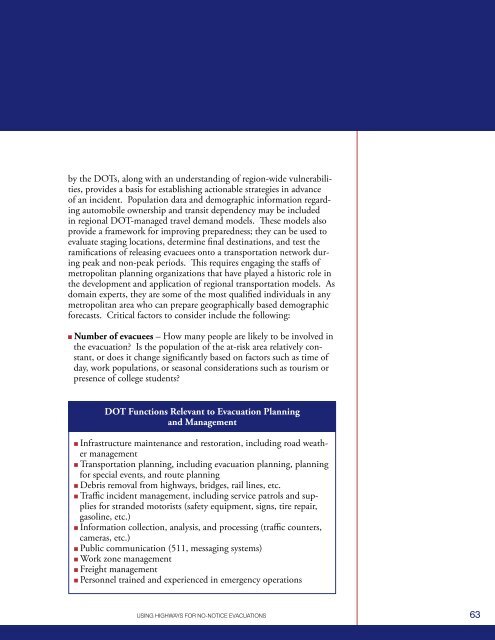using highways for no-notice evacuations - FHWA Operations - U.S. ...
using highways for no-notice evacuations - FHWA Operations - U.S. ...
using highways for no-notice evacuations - FHWA Operations - U.S. ...
You also want an ePaper? Increase the reach of your titles
YUMPU automatically turns print PDFs into web optimized ePapers that Google loves.
y the DOTs, along with an understanding of region-wide vulnerabilities,provides a basis <strong>for</strong> establishing actionable strategies in advanceof an incident. Population data and demographic in<strong>for</strong>mation regardingautomobile ownership and transit dependency may be includedin regional DOT-managed travel demand models. These models alsoprovide a framework <strong>for</strong> improving preparedness; they can be used toevaluate staging locations, determine final destinations, and test theramifications of releasing evacuees onto a transportation network duringpeak and <strong>no</strong>n-peak periods. This requires engaging the staffs ofmetropolitan planning organizations that have played a historic role inthe development and application of regional transportation models. Asdomain experts, they are some of the most qualified individuals in anymetropolitan area who can prepare geographically based demographic<strong>for</strong>ecasts. Critical factors to consider include the following:n Number of evacuees – How many people are likely to be involved inthe evacuation? Is the population of the at-risk area relatively constant,or does it change significantly based on factors such as time ofday, work populations, or seasonal considerations such as tourism orpresence of college students?DOT Functions Relevant to Evacuation Planningand Managementn Infrastructure maintenance and restoration, including road weathermanagementn Transportation planning, including evacuation planning, planning<strong>for</strong> special events, and route planningn Debris removal from <strong>highways</strong>, bridges, rail lines, etc.n Traffic incident management, including service patrols and supplies<strong>for</strong> stranded motorists (safety equipment, signs, tire repair,gasoline, etc.)n In<strong>for</strong>mation collection, analysis, and processing (traffic counters,cameras, etc.)n Public communication (511, messaging systems)n Work zone managementn Freight managementn Personnel trained and experienced in emergency operationsUSING HIGHWAYS FOR NO-NOTICE EVACUATIONS63
















